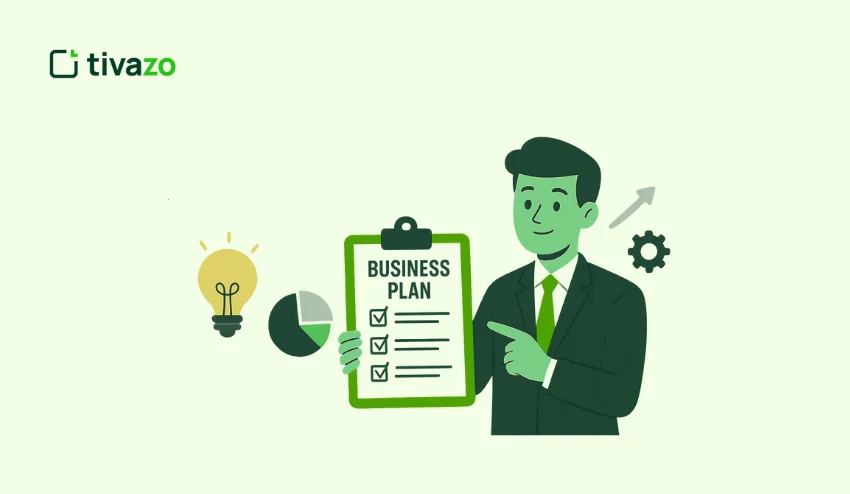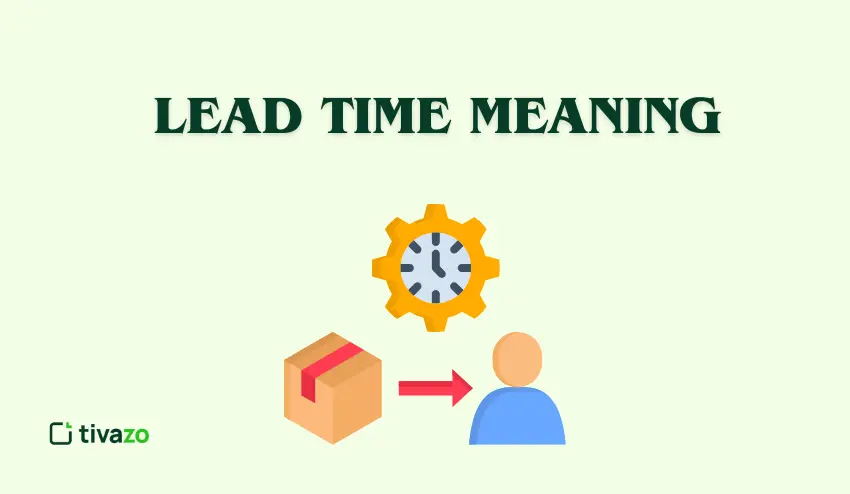You’ve likely invested thousands, possibly tens of thousands, into the payroll that you assemble, but what if I told you that 40% of that is going to non-core tasks, such as administration, IT support, and even basic data entry? If you are paying full-time salaries for jobs that one-time experts could do for you at ten cents on the dollar, you are essentially throwing money away that could be reinvested into your business.
That is why strategic outsourcing exists. By utilizing partners that specialize in specific services, a business can reduce costs, enhance efficiency, and accelerate growth. This article will outline six benefits of outsourcing, lead you through a five-step decision checklist, and provide a playbook for implementing successful outsourced tasks.
Key Highlights:
- What is Strategic Outsourcing
- What are the types of strategic outsourcing
- Why Strategic Outsourcing Matters
- Key Benefits of Strategic Outsourcing
- Practical Steps to Implement Strategic Outsourcing
- Common Risks of Strategic Outsourcing
- When is the right time for strategic outsourcing
What is Strategic Outsourcing?
Strategic outsourcing is an ongoing, performance-based relationship between a business (your company) and a third-party service provider. Only in this case, it is a business arrangement where you stop doing every function in-house and actually hand over tasks done internally (that take up time many employees are paid to do) to external organizations that are much better at doing them for you, and in many cases charged at a lower price to do so.
While traditional outsourcing usually consists simply of turning tasks over to outside contractors, strategic outsourcing is working with partners who have similar goals and Key Performance Indicators as your own company. It focuses on performance enhancement rather than just cutting costs.
What are the types of strategic outsourcing?
Strategic outsourcing consists of hiring an outside organization to handle a specific business function or service for the purpose of attaining greater efficiency, savings, and focusing on core business activities. There are several types of strategic outsourcing, which are classified by the different needs of the business:
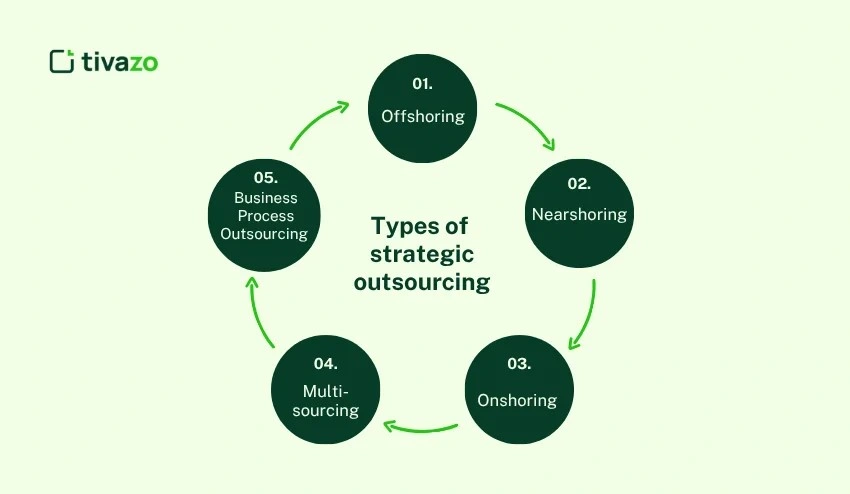
- Offshoring – Outsourcing tasks to a remote country for the purpose of reducing costs.
- Nearshoring – Outsourcing work to a nearby country with a similar time zone and cultural abilities.
- Onshoring – Outsourcing services to a provider within the same country.
- Multi-sourcing – Using multiple service providers located to mitigate risks and improve performance.
- Business Process Outsourcing (BPO) – Outsourcing business processes such as HR, finance, or customer service.
Why Strategic Outsourcing Matters in 2026
The outsourcing world is moving quickly in 2026. Corporations, facing new challenges and global competition, are focusing less on cost saving and more on strategic advantage ones that can help your business attain long-term growth as opposed to short-term savings.
Here are a few reasons why strategic outsourcing is critical to the current marketplace:
- Access to global talent pools: Companies now have access to specialized talent around the world that can help them gain a competitive advantage in areas such as IT, marketing, and customer service.
- Agility and flexibility: Outsourcing enables companies to scale up their operations without the overhead of hiring additional employees.
- Cost-effective innovation: When companies outsource non-core functions, they free up time and resources to devote to rebuilding their core business, driving innovation, and growth.
6 Key Benefits of Strategic Outsourcing
Here are 6 of the most important benefits of strategic outsourcing. Whether you are looking to scale quickly, decrease costs, and improve operational efficiency, outsourcing will provide measurable results.
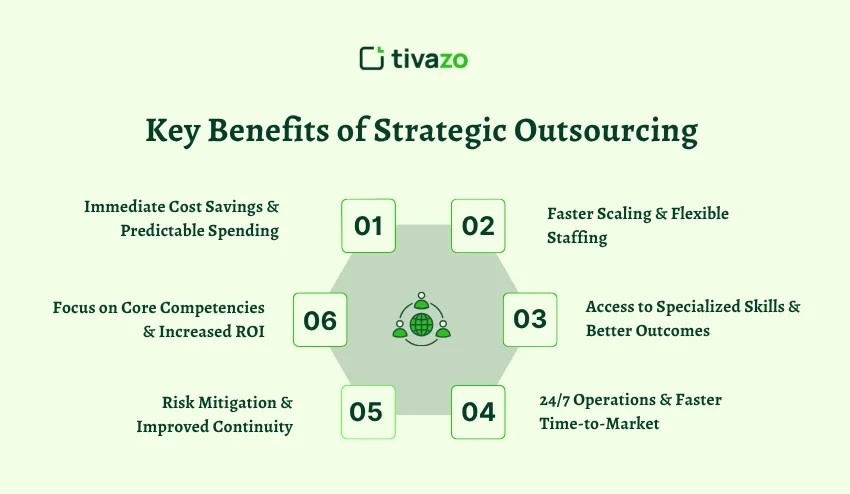
1) Immediate Cost Savings & Predictable Spending
The most advantageous aspect of outsourcing is the immediate cost reduction. With the outsourcing of functions such as customer service, data entry, or IT, you are simply paying a fraction of the cost of hiring for such functions internally.
- Reserve up to 40% in payroll costs by transferring non-core work to an outsourced vendor.
- Pay for each function, rather than a full-time salary, freeing up valuable capital.
- Direct your funds to higher-value activities such as R&D, marketing, or innovation.
2) Faster Scaling & Flexible Staffing
Outsourcing provides the advantage of quickly scaling your business. If there is an increase in demand or you are entering a new market, you do not need to hire a full team internally to meet the demand. Instead, you can quickly fulfill a short-term need by using outsourcing with no ramp-up time. This enables the business to remain agile, respond quickly to changing market conditions, and maintain momentum.
- Rapid ramp-up time with no long internal recruiting effort.
- Scale your team either up or down according to the market demands.
- Agility in operation while devoting time to higher value initiatives.
3) Access to Specialized Skills & Better Outcomes
Instead of investing time and money to train your internal workforce on specific jobs, outsourcing helps fill gaps in expertise quickly. Whether you need specialized IT services, legal research, or content marketing professionals, outsourcing connects you to individuals with specialized skills and experience that can produce superior results, as well as allow you to devote your energy towards the core objectives of your business.
- Engage talent at an elite level without the recruiting process.
- Receive results from experts in the industry with high-quality outcomes.
- Complete tasks more quickly, which compresses the time to delivery.
4) 24/7 Operations & Faster Time-to-Market
When you partner with outsourcing teams to address the various time zones that exist, working conditions include the possibility of 24/7 operations for your business. For organizations that provide customer service and tech support, it is a huge advantage to work with another company in a different time zone you will gain hours of productivity for the cost of a project.
- Provide around-the-clock customer support, with no downtime.
- Provide work into your deadline because you can leverage the different time zones in the world.
- Offer a unique competitive service advantage by providing 24/7 operational capacity for your products or services.
5) Risk Mitigation & Improved Continuity
Outsourcing mitigates risks from staff shortages, compliance challenges, or operational disruptions. Businesses that partner with outsourcing companies will maintain continuity, even when internal resources are strained. For instance, outsourcing can help safeguard from turnover, since staffing will be there to complete tasks on time.
- Less risk of staff turnover and skill shortages.
- Diversify of business functions and reduce reliance on internal staffing.
- Business continuity and timely completion of tasks with a firm outsourced team.
6) Focus on Core Competencies & Increased ROI
By removing non-core duties from your internal team, they will focus on business development and innovation. This will help you better utilize your staff and generate a better return on investment (ROI).
- Concentrate your staff’s time and talent on high-value projects that drive continued business growth.
- Increase your employee engagement and productivity by mitigating fatigue.
- Increase your ROI by delegating those long, time-consuming tasks.
5-Step Decision Checklist: Should You Outsource This?
Before entering into the outsourcing realm, you should determine if outsourcing to a service is even going to be the best route. It’s a powerful tool to utilize, but it’s not the best solution for every task or the best project for every business. Here’s a 5-step checklist of things to consider that weigh in on both thoughts and practical sensibilities to come to an informed decision.
- Value vs. Effort: Is the task aligned to your core business objectives?
- Specialty: Is the task specialized enough that you may not be able to execute in-house?
- Volume: Is the task executed enough to be worth putting on other parties?
- Cost vs. Savings: Will outsourcing save you and improve quality?
- Exit Plan: Do you have an exit plan if outsourcing doesn’t work for you?
You can use this checklist to validate whether you should seriously consider outsourcing.
7 Practical Steps to Implement Strategic Outsourcing
Once you have decided that outsourcing is the right approach for your business operations, the next step is implementation. Follow these 7 steps to set yourself up for success.
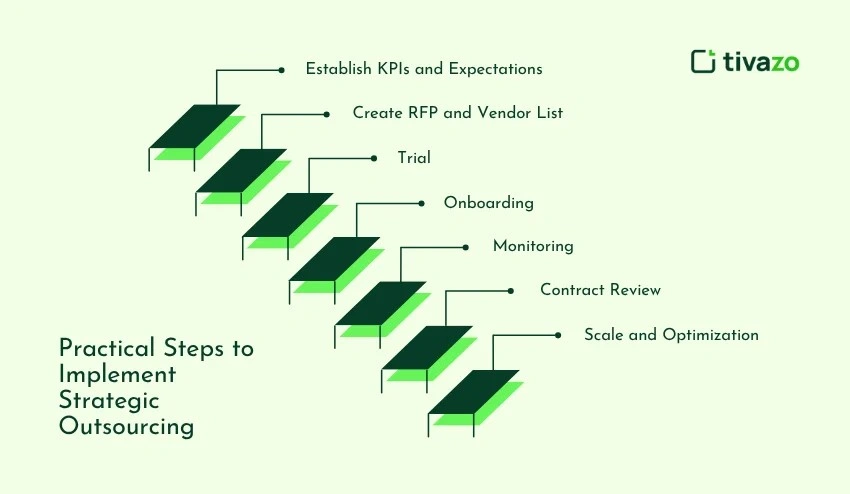
- Establish KPIs and Expectations: Determine specific objectives, such as improved cost-efficiencies, quality, and turnaround time, and unambiguously communicate those performance metrics to ensure clarity of the goals from the very start.
- Create RFP and Vendor List: Identify an initial set of potential vendors, contact them, distribute a Request for Proposal (RFP) to gauge their qualifications, and rank the answers to ensure it align alone with the business formulation.
- Trial: Start with a pilot project where a vendor fulfills the initial project and expectations to allow for correct refitting of future plans.
- Onboarding: Share important information and protocols, and to collaborate initially for speed in learning culture.
- Monitoring: Use tivazo, conduct regular updates to engage this culture of addressing concerns to maintain progress.
- Contract Review: Ensure the contract includes any exit terms, service level agreements (SLAs), and intellectual property rights (IP). Your goal is to align cost and pricing incentives with incentives for both parties, potentially.
- Scale and Optimization: Conduct periodic reviews, citing metrics, to define possible optimization and revise efficiently, and applied cost zones.
Common Risks of Strategic Outsourcing & How to Mitigate Them
Outsourcing comes with risks, even if it brings some important benefits; you should always be aware of the potential pitfalls of outsourcing. It is important to be proactive and anticipate risks to build a strong working relationship with your outsourcing partner.
Here are some common outsourcing risks with controls to mitigate them.
- Loss of control: Protocols, communication, and performance standards need to develop in order to establish and maintain control.
- Data privacy risks: Make sure your outsourcing partner is serious about protecting your data (SOC2, GDPR).
- Unanticipated costs: Pricing should be transparent and honest, without surprises for creep on your project.
- Vendor dependency: Process documentation allows for a transfer of knowledge to mitigate vendor dependency.
- Cultural misalignment: Your outsourcing partner needs to be trained and given guidelines that outline and define their work.
When is the right time for strategic outsourcing?
Strategic outsourcing can be an answer when your company is looking to cut costs, increase efficiencies, or develop advantages around your most important offerings.
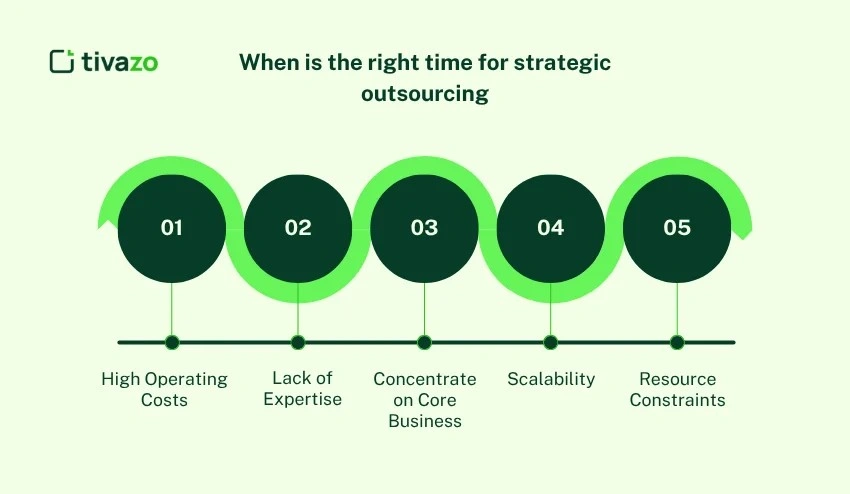
- High Operating Costs: If internal costs are too high or methods are too inefficient, outsourcing can serve as a lower-cost alternative.
- Lack of Expertise: If you require a specialized skill in either technology or a certain talent that doesn’t exist within your organization, outsourcing can help.
- Concentrate on Core Business: If there are non-core ancillary efforts that take you away from your more important business priorities, outsourcing those efforts can free you to concentrate on developing and growing your business and primary offerings.
- Scalability: If your company is beginning to grow and you need to consider a scalable option, outsourcing can be more economical than the required infrastructure investment.
- Resource Constraints: When team resources get stretched and can’t add additional expertise or capabilities, outsourcing is an alternative to burnout or not keeping up with your operations.
Once identified, evaluating in detail the circumstances leads to working your way through whether strategic outsourcing is the right solution to obtain sustainable growth, performance, or enhancement.
How to Build a Long-Term Relationship with Your Outsourcing Partner
A lasting outsourcing relationship starts with clear communication and an ongoing partnership. Here’s a guide to fostering this relationship:
- Set Clear Expectations from Day 1: Setting common goals, timelines, and roles for parties will mitigate misunderstandings.
- Feedback/Communication Process: Regular check-ins to discuss progress and troubleshoot issues will help develop continuity for your partnership.
- Offer Support and Engagement: Treat your partner as an extension of your team and provide resources and funding to help.
- Regularly Review / Optimize: Regularly assessing the partnership and determining if adjustments are is worth consideration when you think there is value to be gained.
Conclusion
Strategic outsourcing is not simply a cost-reduction operation, but a driver of growth, Making your operation lean and agile by slashing overhead, shortening time to market, and focusing on your core operation functions, allowing you to raid and persuade your customer base. It gives your business the ability to employ specialized knowledge, have flexibility and ensure operational continuity. The right outsourcing partner can turn operational challenges into opportunities for innovation and growth. If you desire to get the most out of your business; to achieve operational efficiency through reduced cost, increased quality and asset utilization, and improving your ability to scale, all of this can be accomplished through strategic outsourcing when employed correctly in today’s ever evolving and competitive environment.

